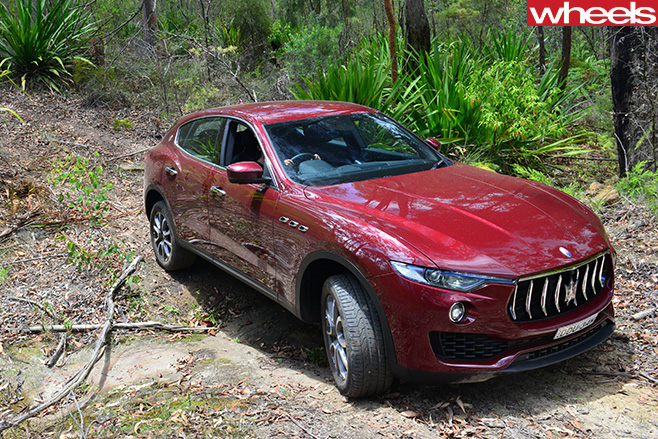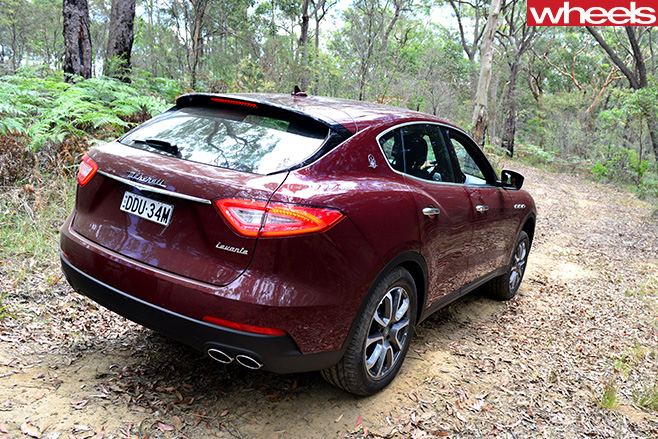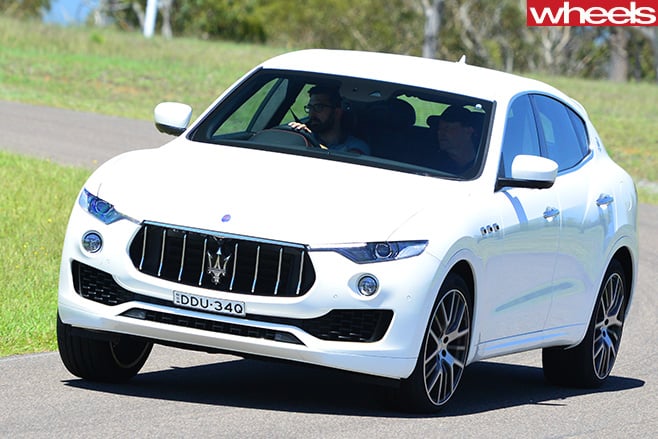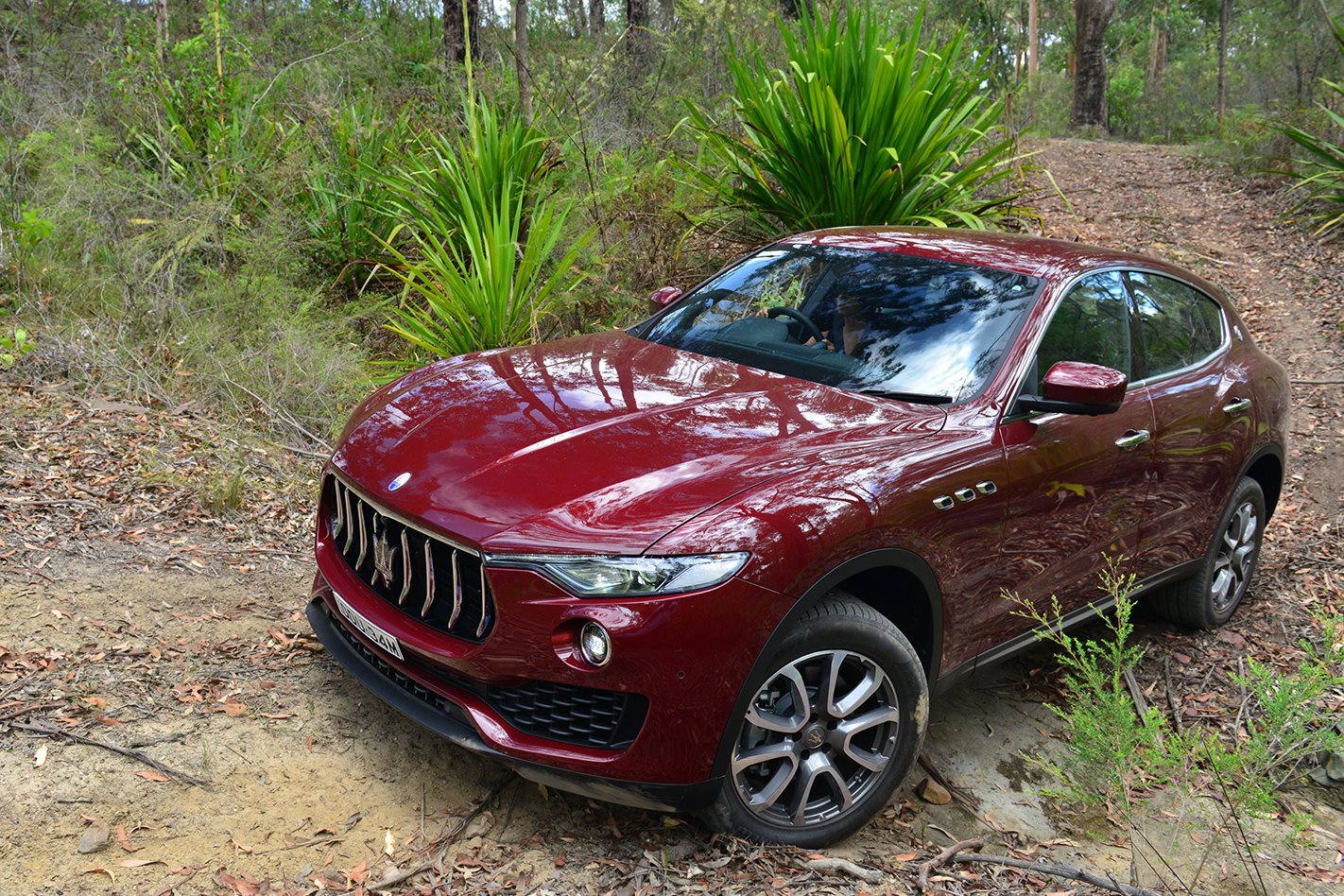LUXURY SUV buyers now have an Italian alternative to the German feast with the Maserati Levante.
WHAT IS IT? Maserati’s first SUV and a five-seater that offers an alternative to predominantly German competitors.
WHY WE’RE TESTING IT The Levante has arrived in Australia and is a key ingredient in plans to double sales for the niche sports car maker.
MAIN RIVALS Any go-fast SUV from the Porsche Macan and Cayenne to the recently arrived Jaguar F-Pace. Then there are the German stalwarts, such as the BMW X5, Audi Q7 and Mercedes-Benz GLE.

PLUS: Laced with trident badges; familiar V6 diesel has decent snarl; competent dynamics; elegant interior
MINUS: Engine not very Maserati; no AEB; heavy; it ain’t cheap
THE WHEELS REVIEW
There’s something NQR about being on the limit of adhesion in a Maserati at 5km/h. Twigs and leaves are crunching under the 19-inch Pirelli P Zeros before the nose dips through a shallow creek crossing.

Despite our vast outback expanses, beaches and myriad mountain ranges, Maserati Australia admits the chances of anyone shelling out upwards of $139,990 on the Italian-made Levante, and then heading for the scrub are slim, although “it’s important that they know they can,” according to Maserati’s Australian chief operating officer, Glen Sealey.
Admittedly the off-road course chosen for the media launch is gentle, indicative more of a choppy track on the road to the country retreat rather than the stuff you’ll typically encounter in the Red Centre.
But the Levante’s off-road mode at least raises the ride height by as much as 40mm.

Ultimately those Pirellis will be the biggest limiting factor on how far you travel beyond the blacktop. Along with rim options stretching up to 20 and 21 inches, the tyres are engineered more for 200km/h-plus autobahn fangs (top speed is 230km/h) or successive switchbacks rather than craggy rocks or sand.
Cop a puncture and you’ll be fumbling with a repair kit or fitting a space-saver spare; the latter only if you’ve ordered it.
But the Levante’s natural habitat is bitumen. That’s where the rear-biased dynamics work with torque vectoring to help point the nose crisply, making for slick and accomplished cornering. Grip levels are high and the five-seater recovers neatly from mid-corner uglies.

Lower the pace and well-weighted steering makes for easy progress, while the suspension copes with all but sharp-edged bumps elegantly.
Under the bonnet is a VM Motori 3.0-litre V6 diesel, something already employed in the Maserati Ghibli and Quattroporte as well as various Jeeps. Maserati has upped outputs to 202kW and 600Nm, the latter arriving in a swell of usable torque from 2000rpm.
Driving through an eight-speed ZF auto with well-spaced ratios it’s claimed to nudge 100km/h in 6.9 seconds. So it’s brisk without anything approaching ballistic.
The noise, too, is better than most V6 diesels courtesy of some nicely tuned plumbing within the induction and exhaust.
But it tapers off as speed increases; something that goes for the performance, too.

The best bit about the engine is how little fuel it uses; claimed consumption is 7.2 litres per 100 kilometres.
Elsewhere the Levante plays the SUV game faithfully, from a spacious back seat and boot to generous storage cubby holes.
The biggest deficiency to the equipment list is autonomous emergency braking. Despite having blind spot and lane departure warnings, the Levante will only warn of a nose-to-tail crash, and not take any action to avoid it.
Yet the Maserati SUV is generally well catered for, with heated leather seats, surround camera, digital radio, smart key entry (only on the front doors) and adjustable air suspension. There’s also Apple CarPlay and Android Auto as part of a tailored 8.4-inch touchscreen also used in various Jeeps and Chryslers. Column-mounted paddle shifters are on all but the base car.
Dig deeper and attention to detail comes to the fore, from the head lining to the leather on the dash. Some switchgear will be familiar to Jeep drivers, but the classy trim choices and traditional touches – such as the oval analogue clock that protrudes from the dash – wins back points.
But playing the game is not what the Levante is about. Its Italian heritage and trident badge is aimed at making it stand out in a sea of predominantly German rivals.
And that, rather than the driving experience, is what most defines the Levante. At least until – and if – the twin-turbo V6 arrives in Australia.
SPECS Model: Levante Turbo Diesel Engine: 2987cc V6 turbo diesel Max power: 202kW @4000rpm Max torque: 600Nm @ 2000-2600rpm Transmission: 8-speed auto Kerb weight: 2205kg 0-100km/h: 6.9sec (claimed) Fuel economy: 7.2L/100km (claimed) Price: $139,990 On sale: Now





